

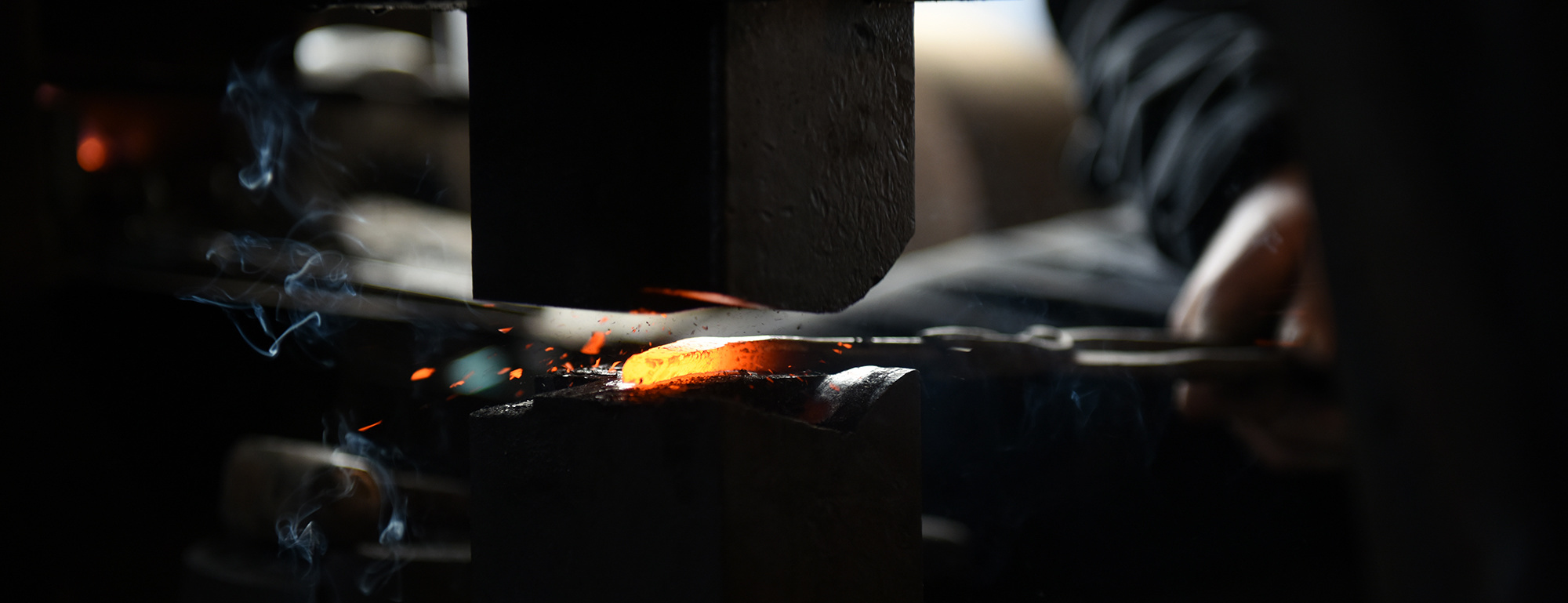
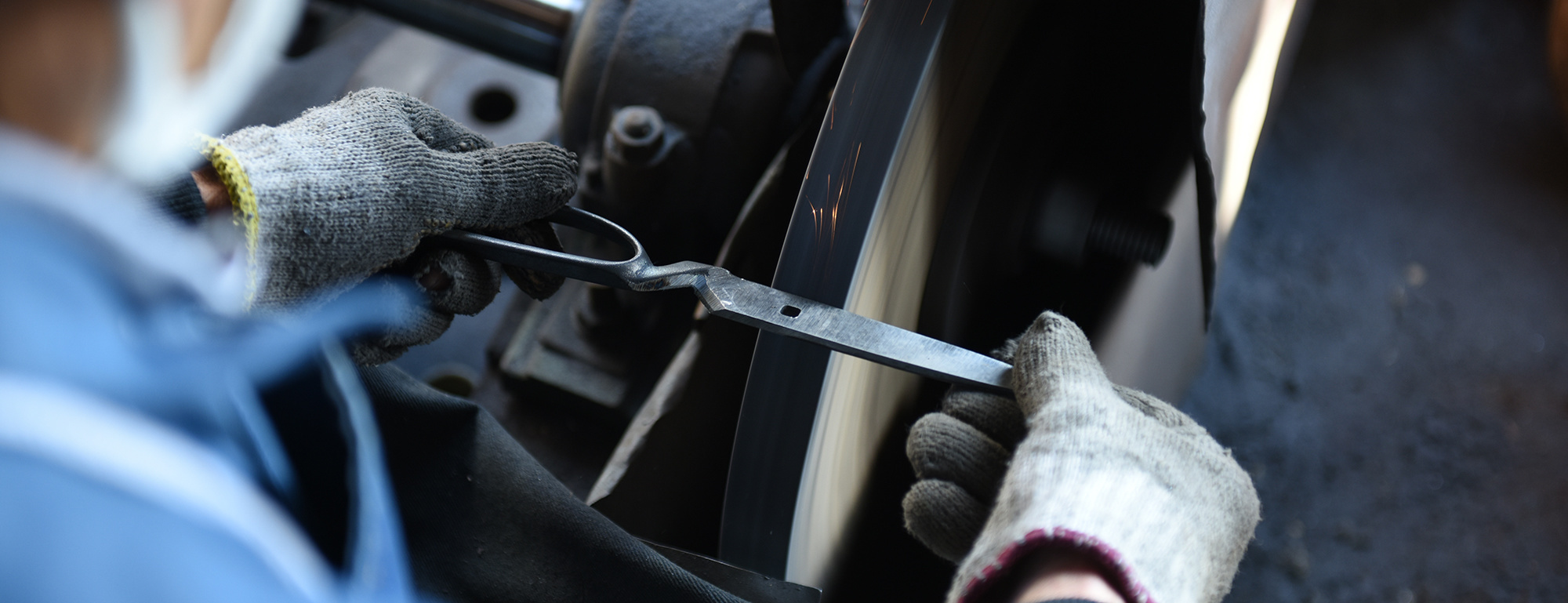
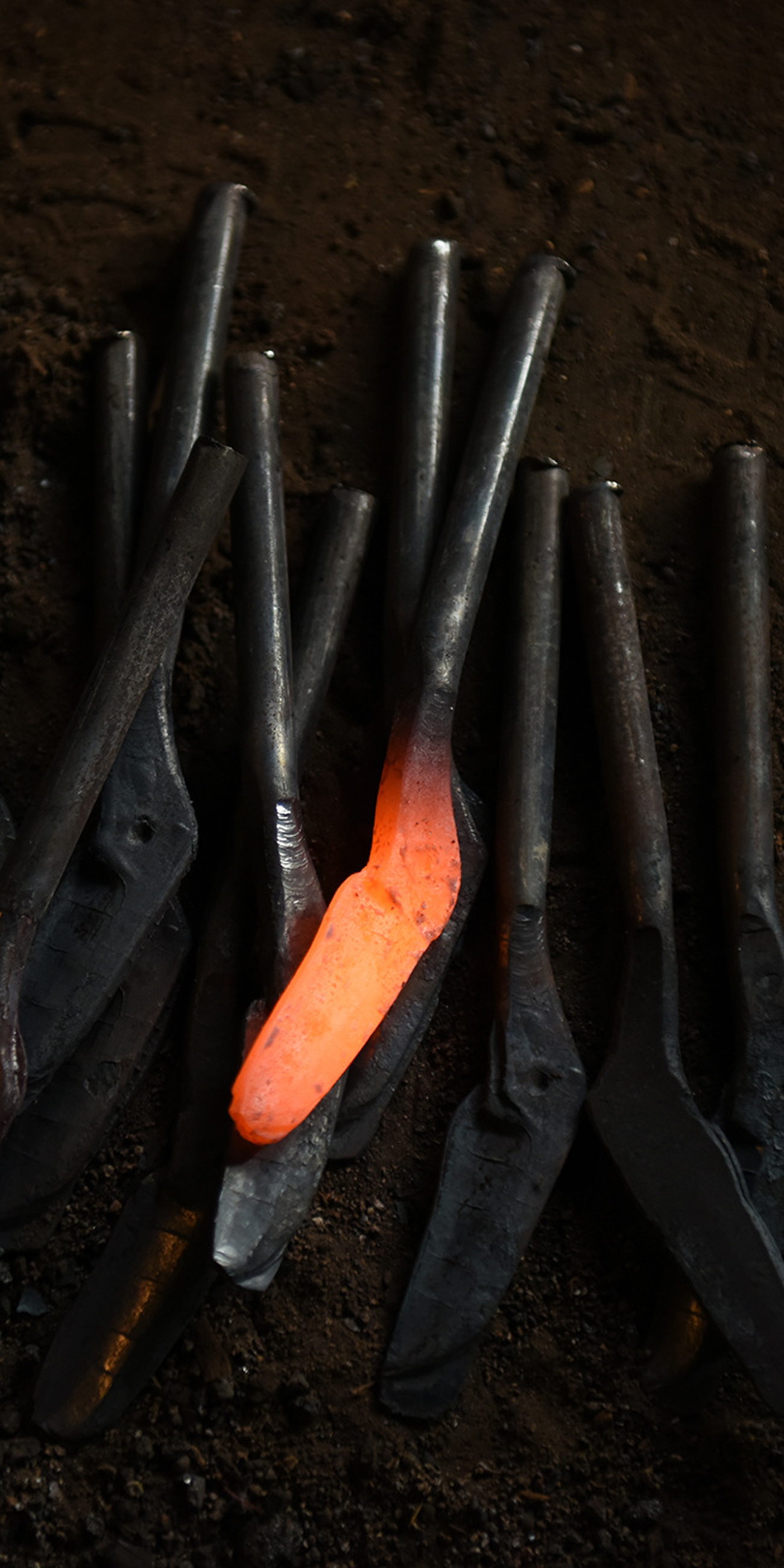
播州刃物とは
播州刃物は日本の鍛冶屋産業の始まりの地とされる、兵庫県の播州地方で作られた刃物製品のブランドです。播州地方の刃物産業には、日本の産業発展とともに成長し、お客様の要望に応じて様々なデザインの刃物を製造してきた歴史があります。一般的な家庭刃物が産業化した歴史も日本一古く、約250年前の江戸時代(18世紀)には既に存在していたとされています。播州刃物には多彩な鋏類があるのが他の地域にはない特徴です。
播磨(現在の兵庫県の播州地域)における鍛冶屋産業は16世紀初頭にはすでに開始していたとされます。1532年には(ごろ)、播磨で日本刀に用いられることで有名な玉鋼の先祖となる千種鋼(ちぐさはがね)が開発されており、 このことからそれ以前にはすでに播州地域で鍛治仕事が盛んに行われていたことがうかがえます。 鋼の製造技術は播州から各地へと伝わり、それが今日の刃物産地の位置関係に通じているとされています。
播州刃物は熟練の職人が一点一点丁寧に手作業で作っています。定期的に研ぐことで、末永く使っていただけます。
What is Banshu Hamono?
Banshu Hamono is a brand of blades, scissors and knives that are produced in the Banshu region in Hyogo prefecture, the oldest region where the blacksmith industry began in Japan. The industry has grown overtime along with the country’s industrial development, and has produced a variety of items to meet the demand. The region is also known for the oldest region where household items were commercialized, dating back to the Edo era in the 18th century. A wide range of scissors is one of the features of Banshu Hamono that is unique to the region.
The blacksmith industry in the Banshu region, which was back then known as Harima, was said to have started as early as in the sixteenth century. By 1532, a type of steel called Chigusa-hagane was developed in the region, which indicates that the region was already home to a bustling blacksmith industry. Chigusa-hagane later became tama-hagane, a type of steel that is famously known for being used to make a katana, or Japanese sword. The technic of making hagane (steel that is used for blades) had spread from the Banshu region to the other parts of Japan. Some of those other regions are still known for making blades today.
Each piece of Banshu Hamono is meticulously handmade by skilled craftsmen. By sharpening regularly, it can be used for a long time.
播州刃物とは
播州刃物は日本の鍛冶屋産業の始まりの地とされる、兵庫県の播州地方で作られた刃物製品のブランドです。播州地方の刃物産業には、日本の産業発展とともに成長し、お客様の要望に応じて様々なデザインの刃物を製造してきた歴史があります。一般的な家庭刃物が産業化した歴史も日本一古く、約250年前の江戸時代(18世紀)には既に存在していたとされています。播州刃物には多彩な鋏類があるのが他の地域にはない特徴です。
播磨(現在の兵庫県の播州地域)における鍛冶屋産業は16世紀初頭にはすでに開始していたとされます。1532年には(ごろ)、播磨で日本刀に用いられることで有名な玉鋼の先祖となる千種鋼(ちぐさはがね)が開発されており、 このことからそれ以前にはすでに播州地域で鍛治仕事が盛んに行われていたことがうかがえます。 鋼の製造技術は播州から各地へと伝わり、それが今日の刃物産地の位置関係に通じているとされています。
播州刃物は熟練の職人が一点一点丁寧に手作業で作っています。定期的に研ぐことで、末永く使っていただけます。


What is Banshu Hamono?
Banshu Hamono is a brand of blades, scissors and knives that are produced in the Banshu region in Hyogo prefecture, the oldest region where the blacksmith industry began in Japan. The industry has grown overtime along with the country’s industrial development, and has produced a variety of items to meet the demand. The region is also known for the oldest region where household items were commercialized, dating back to the Edo era in the 18th century. A wide range of scissors is one of the features of Banshu Hamono that is unique to the region.
The blacksmith industry in the Banshu region, which was back then known as Harima, was said to have started as early as in the sixteenth century. By 1532, a type of steel called Chigusa-hagane was developed in the region, which indicates that the region was already home to a bustling blacksmith industry. Chigusa-hagane later became tama-hagane, a type of steel that is famously known for being used to make a katana, or Japanese sword. The technic of making hagane (steel that is used for blades) had spread from the Banshu region to the other parts of Japan. Some of those other regions are still known for making blades today.
Each piece of Banshu Hamono is meticulously handmade by skilled craftsmen. By sharpening regularly, it can be used for a long time.

播州刃物の歴史
古文書によれば、延享年間(1744年~48年)に剃刀(又右衛門)の始業を見ることができます。その後、にぎり鋏(宗兵衛)が文化3年(1807)、包丁も文化年間(1804年~1818年)、ナイフ(井上仁三郎)は明治44年、裁鋏(ラシャ切鋏)が昭和5年に始まったと伝えられています。これらの家庭刃物は、播州地方で(小野周辺に)農業の副業として広がり、優れた生産技術、恵まれた労働力により発展しました。
さらに、明治維新による社会情勢の急変で鋏類の技術研究や製品の考案が進み、裁鋏をはじめ、池の坊鋏、剪定鋏、散髪鋏も開発され、次第に業者も増大して刃物産地としての基盤を確立しました。
鎌も播州地域で広く生産されている製品です。鎌は、全国生産量の80%を占め、約200年の歴史があります。旧一柳藩の抱え刀鍛冶、藤原伊助がナイフの製造技術を応用して鎌の製法の改良を始め、その鋭利さが消費者に喜ばれ、「カミソリ鎌」という愛称で全国に広まりました。
戦後は農業の機械化に伴い、刃物製造へのリソースが増え、品質や技術が改善し、播州は刃物産地としてさらに前進しました。播州には鎌や鋏類の家庭刃物に加えて、工具、大工道具類などの数多くの産品があり、 複合材の開発やステンレス鋼材等による品質改善、技術研究による伸張を続け、さらに設備の近代化に伴い、当業界に君臨し、播州地方の(その)優れた製品は全国の消費者に知られるようになりました。
しかし、手作りの鍛冶屋分野における職人の商品は、量産品に押され、近年において播州地方の産業規模は大幅に縮小。職人は高齢化し、その職人技を引き継ぐ、若い後継者も不足しています。後継者問題はいま播州地方においてもっとも深刻な課題です。
播州地方の職人技をまもり伝えることで、この状況を解決しようと、2013年に合同会社シーラカンス食堂(MUJUN)は、小野金物卸商業組合の依頼を受け、新しい地域ブランド「播州刃物」をつくりました。播州刃物は産地を代表する各分野の様々な刃物職人で構成されたブランドです。わたしたちの歴史、品質、職人技を喜んでくださるお客様と共に、伝統の技を守り、未来の職人を育んでいくことがこのブランドの役割です。
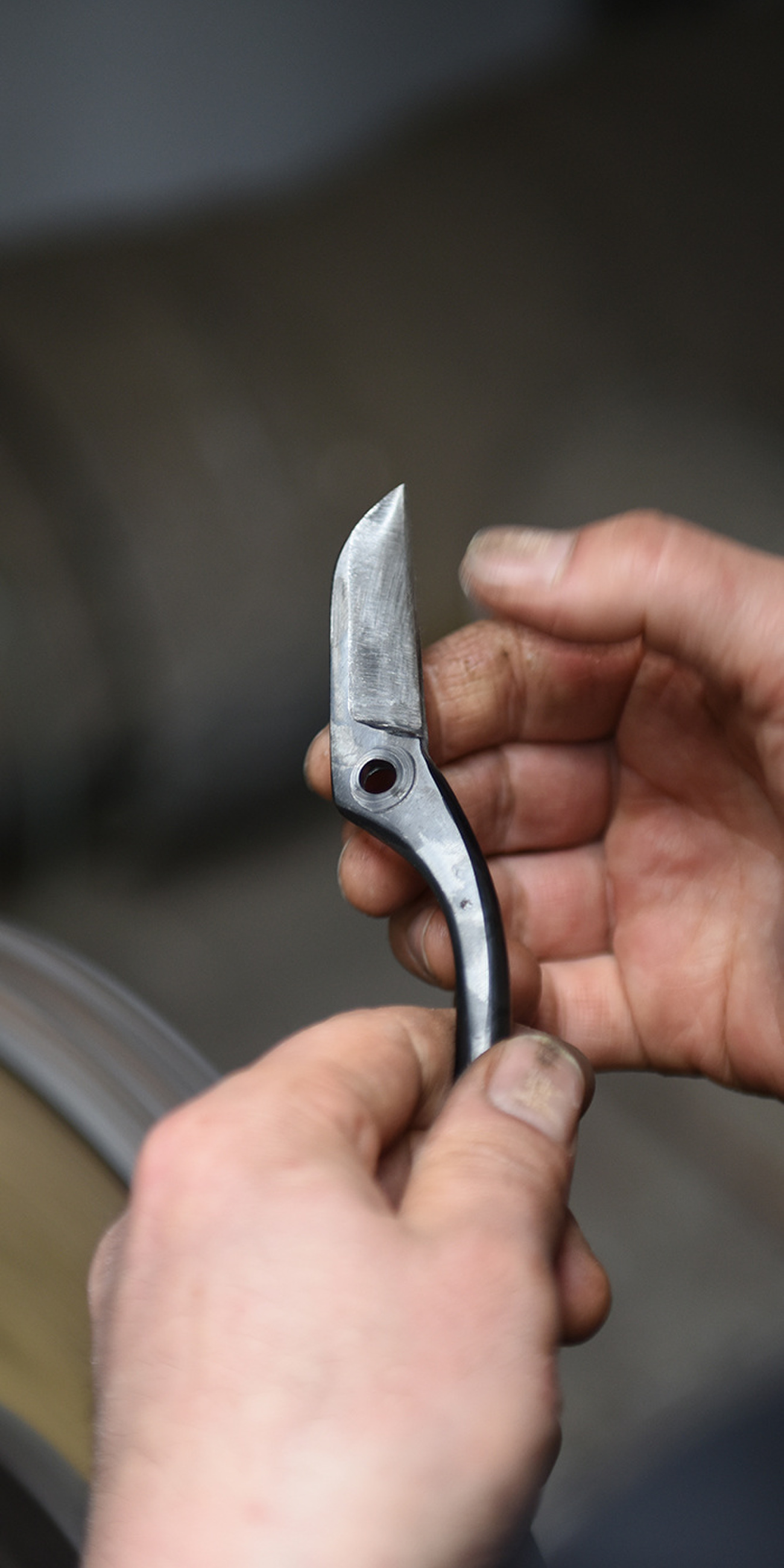
播州刃物の歴史
古文書によれば、延享年間(1744年~48年)に剃刀(又右衛門)の始業を見ることができます。その後、にぎり鋏(宗兵衛)が文化3年(1807)、包丁も文化年間(1804年~1818年)、ナイフ(井上仁三郎)は明治44年、裁鋏(ラシャ切鋏)が昭和5年に始まったと伝えられています。これらの家庭刃物は、播州地方で(小野周辺に)農業の副業として広がり、優れた生産技術、恵まれた労働力により発展しました。
さらに、明治維新による社会情勢の急変で鋏類の技術研究や製品の考案が進み、裁鋏をはじめ、池の坊鋏、剪定鋏、散髪鋏も開発され、次第に業者も増大して刃物産地としての基盤を確立しました。
鎌も播州地域で広く生産されている製品です。鎌は、全国生産量の80%を占め、約200年の歴史があります。旧一柳藩の抱え刀鍛冶、藤原伊助がナイフの製造技術を応用して鎌の製法の改良を始め、その鋭利さが消費者に喜ばれ、「カミソリ鎌」という愛称で全国に広まりました。
戦後は農業の機械化に伴い、刃物製造へのリソースが増え、品質や技術が改善し、播州は刃物産地としてさらに前進しました。播州には鎌や鋏類の家庭刃物に加えて、工具、大工道具類などの数多くの産品があり、 複合材の開発やステンレス鋼材等による品質改善、技術研究による伸張を続け、さらに設備の近代化に伴い、当業界に君臨し、播州地方の(その)優れた製品は全国の消費者に知られるようになりました。
しかし、手作りの鍛冶屋分野における職人の商品は、量産品に押され、近年において播州地方の産業規模は大幅に縮小。職人は高齢化し、その職人技を引き継ぐ、若い後継者も不足しています。後継者問題はいま播州地方においてもっとも深刻な課題です。
播州地方の職人技をまもり伝えることで、この状況を解決しようと、2013年に合同会社シーラカンス食堂(MUJUN)は、小野金物卸商業組合の依頼を受け、新しい地域ブランド「播州刃物」をつくりました。播州刃物は産地を代表する各分野の様々な刃物職人で構成されたブランドです。わたしたちの歴史、品質、職人技を喜んでくださるお客様と共に、伝統の技を守り、未来の職人を育んでいくことがこのブランドの役割です。
/ How Banshu Hamono Went Global
播州刃物、グローバル展開の軌跡
/ How Banshu Hamono Went Global

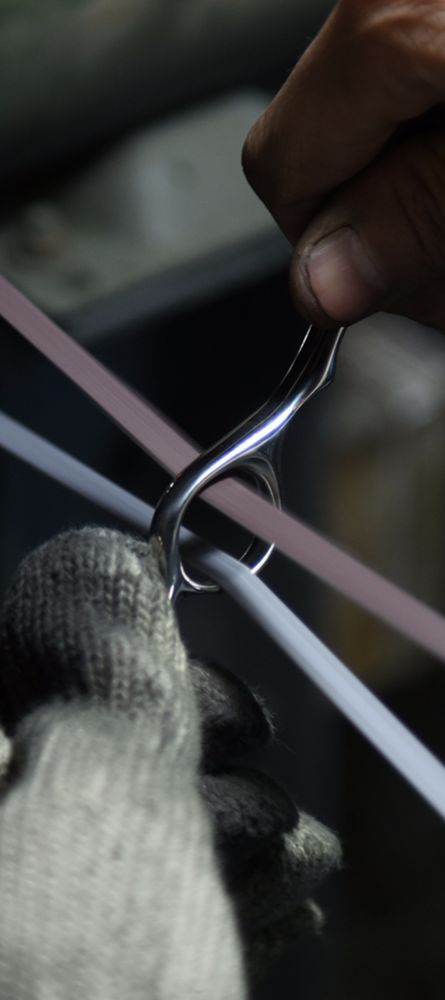
History of Banshu Hamono
According to the historic record, the oldest straight razor was made by Matauemon in the Enkyo era (1744-48). It is said that Japanese grip scissors were first produced by Sobei in 1807 during the Bunka era (1804-18) while the first kitchen knives were also made in the same period. In 1911 during the Meiji era (1868-1912), Jinzaburo Inoue began making knives. Furthermore, the making of fabric scissors started in 1930 in the Showa era (1926-1989). These household items were developed by farmers in the Banshu region as their side work. The industry could thrive due to the availability of the workforce and their excellent production skills.
After the Meiji Restoration in 1868 and the following industrialization, the types of scissors expanded because of the technological research and product development. In addition to fabric scissors, Ikenobo ikebana scissors, secateurs, and haircut scissors were developed. The number of makers had also increased, and the foundation of the blacksmith industry was established in the region.
A sickle is another item that is widely produced in the Banshu region. Sickles were produced in the region for about 200 years, and it produces 80% of the total sickles produced in Japan. Isuke Fujiwara, who was an in-house katana swordsmith for the Hitotsuyanagi clan, improved the production process for sickles by applying the technic of knifemaking. His sickles were exceptionally sharp, and became popular nationwide. People called his sickles as Kamisori Gama, or razor-sharp sickles.
After the Second World War, automation in the farming led to more resources available for blacksmith, and the product quality and the techniques were improved. As a result, the industry further flourished in the Banshu region. The region does not only produce household items like scissors and sickles, but it also produces industrial tools and carpenter tools. Besides having the product variety, quality has also improved because of the technical research and the development of the new materials like composite material and stainless steel. In addition, modern facilities further improved productivity, and the region established itself as one of the most prominent regions for the blacksmith industry. Consequently, the quality products from the Banshu region became popular across Japan.
However, the industry became much smaller in the recent years, as hand-crafted items could not compete with the mass-produced alternatives. Existing craftsmen are getting old, and there are not enough young people who inherit their skills. This is the biggest challenge the region faces at the moment.
To address this issue by advocating and promoting the craftsmanship in the Banshu region, Mujun worked with Ono Kanamono Association, an association of local blacksmiths, and created a local brand, Banshu Hamono in 2013. It is a label which has a collection of items made by various blade-makers in the region. The role of the brand is to preserve traditional skills and to nurture the future craftsmen - together with the customers around the world who appreciate our history, quality, and craftsmanship.

History of Banshu Hamono
According to the historic record, the oldest straight razor was made by Matauemon in the Enkyo era (1744-48). It is said that Japanese grip scissors were first produced by Sobei in 1807 during the Bunka era (1804-18) while the first kitchen knives were also made in the same period. In 1911 during the Meiji era (1868-1912), Jinzaburo Inoue began making knives. Furthermore, the making of fabric scissors started in 1930 in the Showa era (1926-1989). These household items were developed by farmers in the Banshu region as their side work. The industry could thrive due to the availability of the workforce and their excellent production skills.
After the Meiji Restoration in 1868 and the following industrialization, the types of scissors expanded because of the technological research and product development. In addition to fabric scissors, Ikenobo ikebana scissors, secateurs, and haircut scissors were developed. The number of makers had also increased, and the foundation of the blacksmith industry was established in the region.
A sickle is another item that is widely produced in the Banshu region. Sickles were produced in the region for about 200 years, and it produces 80% of the total sickles produced in Japan. Isuke Fujiwara, who was an in-house katana swordsmith for the Hitotsuyanagi clan, improved the production process for sickles by applying the technic of knifemaking. His sickles were exceptionally sharp, and became popular nationwide. People called his sickles as Kamisori Gama, or razor-sharp sickles.
After the Second World War, automation in the farming led to more resources available for blacksmith, and the product quality and the techniques were improved. As a result, the industry further flourished in the Banshu region. The region does not only produce household items like scissors and sickles, but it also produces industrial tools and carpenter tools. Besides having the product variety, quality has also improved because of the technical research and the development of the new materials like composite material and stainless steel. In addition, modern facilities further improved productivity, and the region established itself as one of the most prominent regions for the blacksmith industry. Consequently, the quality products from the Banshu region became popular across Japan.
However, the industry became much smaller in the recent years, as hand-crafted items could not compete with the mass-produced alternatives. Existing craftsmen are getting old, and there are not enough young people who inherit their skills. This is the biggest challenge the region faces at the moment.
To address this issue by advocating and promoting the craftsmanship in the Banshu region, Mujun worked with Ono Kanamono Association, an association of local blacksmiths, and created a local brand, Banshu Hamono in 2013. It is a label which has a collection of items made by various blade-makers in the region. The role of the brand is to preserve traditional skills and to nurture the future craftsmen - together with the customers around the world who appreciate our history, quality, and craftsmanship.

